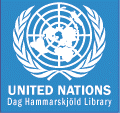The established form of a geographical place
name should be used, whether as a geographic qualifier (additions to
corporate and conference names) or as a subject, and cataloguers and
indexers are expected to submit new names to the Authority Coordinator
for review.
DHL
used to maintain a separate list of geographic place names
indicating the form and spelling to use in UNBIS records. These names
are now maintained in the Thesaurus database but they are not treated
as Thesaurus terms--they are not
translated or incorporated into the Thesaurus structure, nor do they
appear in the public version on the Web. A «List
of Geographic Names», extracted from the Thesaurus
database, is sent periodically to other libraries in the UN system
which use the Thesaurus.
The
form of the name and appropriate cross-references are chosen in
consultation with the Map Librarian. Normally the English conventional
form of a name is preferred (e.g., Vienna, not Wien), but attention
also is paid to the spelling on UN maps.
When
a geographical place name is a subject,
it is expressed in upper case, just as Thesaurus terms are. Also, the
country name is added to city, state and province names but not to
geographic features, such as islands, mountains, rivers, etc., if they
are
shared by two or more countries or other jurisdictional bodies. It may
be necessary to distinguish a city and another jurisdictional entity
with the same name (Québec, for example, is the name of a city
and a province).
Examples:
QUEBEC (CANADA :
PROVINCE)
ZAMBEZI NATIONAL PARK (ZIMBABWE)
YUKON TERRITORY (CANADA)
WINDWARD ISLANDS
RED SEA REGION
PYRENEES
PENNSYLVANIA (UNITED STATES)
PANAMA CANAL
ORLOVSKAIA OBLAST' (RUSSIAN FEDERATION)
NIGER RIVER BASIN
NABLUS (WEST BANK)
MEDINA (SAUDI ARABIA)
ESFAHAN (ISLAMIC REPUBLIC OF IRAN)
MACAO (CHINA : SPECIAL ADMINISTRATIVE REGION)
LIPTAKO REGION (BURKINA FASO)
LITANI RIVER (LEBANON) [confined to Lebanon]
AMAZON RIVER
ALEUTIAN ISLANDS (UNITED STATES)
LOS ANGELES (CALIF.)
LOS ANGELES COUNTY (CALIF.)
SCOTLAND (UNITED KINGDOM)
CLYDEBANK (SCOTLAND)
AZORES (PORTUGAL)
BALTIC STATES
BARENTS SEA
BEAGLE CHANNEL
CENTRAL EUROPE
CHAGOS ARCHIPELAGO
CROZET ISLANDS (FRENCH SOUTHERN AND ANTARCTIC LANDS)
DAGESTAN (RUSSIAN FEDERATION)
EAST CENTRAL PACIFIC OCEAN REGION
FLANDERS (BELGIUM)
GAZA STRIP
GREAT LAKES REGION (AFRICA)
GREAT LAKES REGION (NORTH AMERICA)
GREENLAND
GUANTANAMO BAY NAVAL BASE (CUBA)
GUAYANA SHIELD
GULF OF FONSECA
HAGUE (NETHERLANDS) [note: initial article
suppressed]
JUBA VALLEY
(SOMALIA)
HELMAND RIVER VALLEY
Note that the
Thesaurus
does include some geographic names, countries, of course, but also
continents, some major geographic regions and a few island groups and
bodies of water:
ADRIATIC SEA
AFRICA SOUTH OF THE SAHARA
ANDEAN REGION
ARAB COUNTRIES
ASIA AND THE PACIFIC
EAST AFRICA
CHANNEL ISLANDS
This is a
legacy issue which becomes a problem when it would seem logical to
create reciprocal cross-references between two related headings, but
one can't because one is a Thesaurus term and the other a geographical
name that does not appear in the Thesaurus. For example,
FALKLAND ISLANDS
(MALVINAS) and
FALKLAND ISLANDS
(MALVINAS) DEPENDENCIES
The first is a Thesaurus term and the second (the
pre-1985 designation) a "geographic name" term.
It
is sometimes necessary to add an explanatory note, such as:
BALUCHISTAN
(Region, W. Asia, encompassing territory
lying in E. Iran and SW. Pakistan)
CZECH REPUBLIC
(For works published or which cover the
period prior to 31 Dec. 1992, use Czechoslovakia as an added descriptor)
DEMOCRATIC YEMEN
(Used until May 21, 1990. On May 22, 1990, merged with the Yemen Arab Republic (YEMEN)
to form the Republic of Yemen (YEMEN))
Name
changes - see AACR2 23.3A
When
the name of a country changes, if there is no jurisdictional
change, the Thesaurus term changes to the
latest form of the name, but only after confirmation in a
memo from the UN Office of Protocol. The division's Director
and the Authority
Control Coordinator receive
this memo. UNTERM
may be consulted for the short form of the name, which is used in
UNBIS, e.g. "Iran
(Islamic Republic of)", "Venezuela (Bolivarian Republic of)" and
"Bolivia (Plurinational State of)". Also, the country
name used as a qualifier in a subject
heading must be updated. Thus,
On the other hand, if there is a
jurisdictional
change, both old and new forms of the name are retained,
linked by
reciprocal cross-references. For example:
Thesaurus
terms:
CAMEROON
CAMEROONS UNDER BRITISH ADMINISTRATION
CAMEROONS UNDER FRENCH ADMINISTRATION
Corporate
name headings:
110
2 _ $a Democratic
Kampuchea
510 2 _ $a Cambodia
Country
codes
UNBIS
uses the ISO 3166-1 alpha-3 codes, three-letter country codes in the
ISO 3166-1 standard to represent countries and dependent areas. The
Authority Control Coordinator must be alert for changes in the codes,
which are to be expected when a country changes names. New codes will
not be adopted immediately, as they are decided by an international
committee. The code lists can be consulted on the
ISO 3166 website, and approved updates will appear in its newsletter.
The changes should be reported to the UNBIS database manager and the
Map Librarian. The UN
Statistics Division.
Maintained
by the Department of Public Information (DPI), Dag Hammarskjöld
Library. Comments as well as suggestions for further
additions/enhancements may be directed to the Dag Hammarskjöld
Library.
© United Nations 2007-2009. All rights reserved.
Last
updated: 20 August 2009
|
